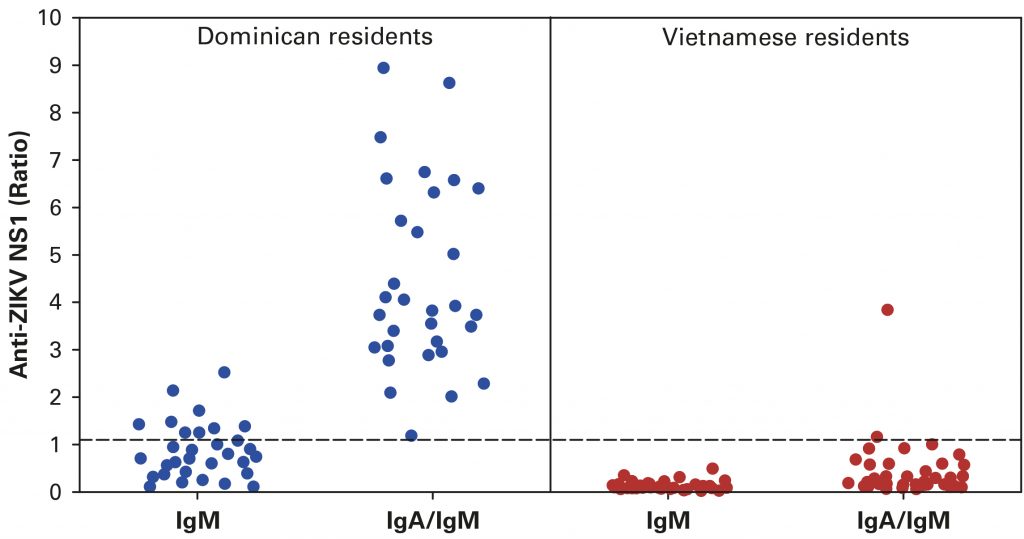Previous year, EUROIMMUN launched the Anti-Zika Virus ELISA IgA. It had turned out that specific anti-Zika virus IgA antibodies against the non-structural protein 1 (NS1) could serve as alternative indicators of acute infection phase if specific IgM antibodies were not detectable. Particularly when patients, who already have had a first contact with a flavivirus (infection or vaccination), become infected with another virus of the genus, in this case Zika virus, the specific IgM response may be absent (secondary immune response). In these cases, determination of anti-Zika virus IgA may facilitate the diagnosis of acute infection.
Anti-Zika virus IgA and IgM antibodies
Internal studies, however, assessed that not in every patient with an acute Zika virus infection specific IgM and IgA antibodies can be detected, but that all tested samples were reactive for at least one of the two immunoglobulin classes (anti-Zika virus IgM or IgA). Consequently, another ELISA has been developed for the combined detection of anti-Zika virus IgA and IgM. The diagnostic benefit of the novel assay has been determined in comparison to the Anti-Zika virus ELISA IgM in a further study.
 Serum samples of 31 patients with confirmed acute Zika virus infection from the Dominican Republic (where Zika and dengue viruses are endemic) as well as 40 Vietnamese patients with acute dengue virus infection were tested. As a result, the Anti-Zika virus ELISA IgAM turned out to be 100% sensitive (31/31) and 95% specific (38/40) compared to a sensitivity of 29% (9/31) and a specificity of 100% (40/40) for the Anti-Zika virus ELISA IgM. Thus, the combined detection of both antibody classes instead of isolated IgM leads to a threefold increase of sensitivity for acute Zika virus infections without significant loss of specificity.
Serum samples of 31 patients with confirmed acute Zika virus infection from the Dominican Republic (where Zika and dengue viruses are endemic) as well as 40 Vietnamese patients with acute dengue virus infection were tested. As a result, the Anti-Zika virus ELISA IgAM turned out to be 100% sensitive (31/31) and 95% specific (38/40) compared to a sensitivity of 29% (9/31) and a specificity of 100% (40/40) for the Anti-Zika virus ELISA IgM. Thus, the combined detection of both antibody classes instead of isolated IgM leads to a threefold increase of sensitivity for acute Zika virus infections without significant loss of specificity.
Early diagnosis of acute infections with Zika viruses is particularly important for pregnant women since the virus may interfere with the neurological development of the fetus and can cause microcephaly. However, also in adults the viral infection may have neurological long term consequences. Therefore, timely recognition of this infectious disease is required.
For further information: http://www.zika-diagnostics.com/

